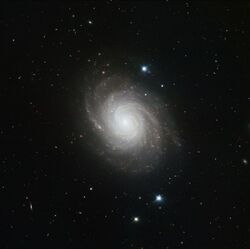Astronomy:NGC 4030
| NGC 4030 | |
|---|---|
 | |
| Observation data (J2000 epoch) | |
| Constellation | Virgo |
| Right ascension | 12h 00m 23.643s[2] |
| Declination | –01° 05′ 59.87″[2] |
| Helio radial velocity | 1,465[3] km/s |
| Distance | 63.6 ± 4.9 Mly (19.5 ± 1.5 Mpc)[3] |
| Apparent magnitude (V) | 10.6[4] |
| Characteristics | |
| Type | SA(s)bc[3] |
| Apparent size (V) | 3′.8 × 2′.9[4] |
| Other designations | |
| PGC 37845, UGC 6993[3] | |
NGC 4030 is a grand design spiral galaxy[5] located about 64[3] million light years away in the constellation Virgo. It is a member of the NGC 4030 Group of galaxies, which is a member of the Virgo II Groups, a series of galaxies and galaxy clusters strung out from the southern edge of the Virgo Supercluster.[6] With an apparent visual magnitude of 10.6, it is visible with a small telescope as a 3 arc minute wide feature about 4.75° to the southeast of the star Beta Virginis.[4] It is inclined by an angle of 47.1°[3] to the line of sight from the Earth and is receding at a velocity of 1,465 km/s.[3]
The morphological classification of NGC 4030 in the De Vaucouleurs system is SA(s)bc,[3] which indicates a spiral structure (SA) with no bar (s) and moderate to loosely wound arms (bc).[7] The inner part of the galaxy shows a complex structure with multiple spiral arms, which becomes a symmetric, double arm pattern beyond 49″ from the core.[5] The central bulge is relatively young with an estimated age of two billion years,[8] while the nucleus is inactive.[9]
In 2007, a supernova explosion was discovered in the galaxy from images taken on February 19 from the 1 m Swope telescope at Las Campanas Observatory in Chile. Designated SN 2007aa, it was a type IIP[10] supernova positioned 68″.5 north and 60″.8 east of the galactic nucleus.[11] The progenitor was a red giant star with 8.5–16.5 times the mass of the Sun.[10]
Gallery
NGC 4030 imaged by the Hubble Space Telescope
References
- ↑ HAWK-I image of NGC 4030, European Southern Observatory, October 27, 2010, https://www.eso.org/public/images/eso1042e/, retrieved 2013-07-19.
- ↑ 2.0 2.1 Skrutskie, Michael F.; Cutri, Roc M.; Stiening, Rae; Weinberg, Martin D.; Schneider, Stephen E.; Carpenter, John M.; Beichman, Charles A.; Capps, Richard W. et al. (1 February 2006). "The Two Micron All Sky Survey (2MASS)". The Astronomical Journal 131 (2): 1163–1183. doi:10.1086/498708. ISSN 0004-6256. Bibcode: 2006AJ....131.1163S.
- ↑ 3.0 3.1 3.2 3.3 3.4 3.5 3.6 3.7 Crowther, Paul A. (January 2013), "On the association between core-collapse supernovae and H II regions", Monthly Notices of the Royal Astronomical Society 428 (3): 1927–1943, doi:10.1093/mnras/sts145, Bibcode: 2013MNRAS.428.1927C.
- ↑ 4.0 4.1 4.2 O'Meara, Stephen James (2007), Steve O'Meara's Herschel 400 Observing Guide, Cambridge University Press, p. 133, ISBN 978-0521858939, https://books.google.com/books?id=Nyh9fAC_tpIC&pg=PA133.
- ↑ 5.0 5.1 Grosbøl, P.; Dottori, H. (June 2012), "Star formation in grand-design, spiral galaxies. Young, massive clusters in the near-infrared", Astronomy & Astrophysics 542: A39, doi:10.1051/0004-6361/201118099, Bibcode: 2012A&A...542A..39G.
- ↑ "The Virgo III Groups". Atlas of the Universe. http://www.atlasoftheuniverse.com/galgrps/viriii.html.
- ↑ Buta, Ronald J. et al. (2007), Atlas of Galaxies, Cambridge University Press, pp. 13–17, ISBN 978-0521820486, https://books.google.com/books?id=g-P7dCbB5MEC&pg=PA16.
- ↑ Ocvirk, P. et al. (December 2008), "Extragalactic archeology in integrated light: A test case with NGC 4030", Astronomische Nachrichten 329 (9–10): 980–983, doi:10.1002/asna.200811075, Bibcode: 2008AN....329..980O.
- ↑ Hicks, E. K. S. et al. (May 2013), "Fueling Active Galactic Nuclei. I. How the Global Characteristics of the Central Kiloparsec of Seyferts Differ from Quiescent Galaxies", The Astrophysical Journal 768 (2): 107, doi:10.1088/0004-637X/768/2/107, Bibcode: 2013ApJ...768..107H.
- ↑ 10.0 10.1 Chornock, Ryan et al. (April 2010), "Large Late-Time Asphericities in Three Type IIP Supernovae", The Astrophysical Journal 713 (2): 1363–1375, doi:10.1088/0004-637X/713/2/1363, Bibcode: 2010ApJ...713.1363C.
- ↑ Folatelli, G. et al. (February 2007), "Supernova 2007aa in NGC 4030", Central Bureau Electronic Telegrams 850: 1, Bibcode: 2007CBET..850....1F.
External links
 |



